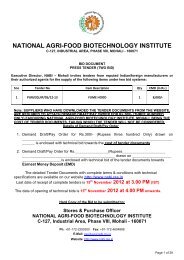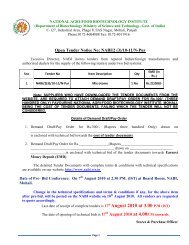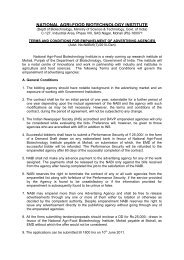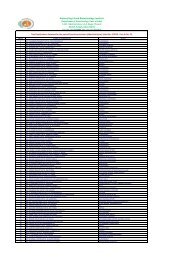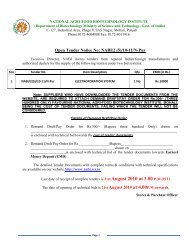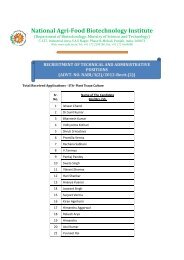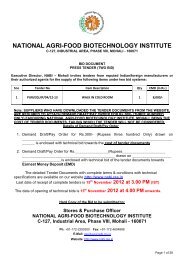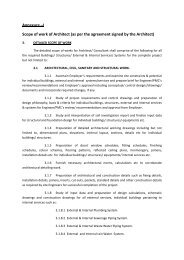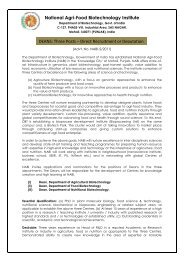Annual Report 2011-2012 - Nabi.res.in
Annual Report 2011-2012 - Nabi.res.in
Annual Report 2011-2012 - Nabi.res.in
- No tags were found...
Create successful ePaper yourself
Turn your PDF publications into a flip-book with our unique Google optimized e-Paper software.
NATIONAL AGRI-FOOD BIOTECHNOLOGY INSTITUTE5. COMPUTATIONAL BIOLOGY APPROACHES FORMARKER AND GENE DISCOVERY FOR NUTRITION ANDPROCESSING TRAITS IN GENOMES OF FOOD CROPS5.1 Development of advanced algorithms, Research Objectives:databases, tools and pipel<strong>in</strong>e for data m<strong>in</strong><strong>in</strong>gland comparative analysis of food cropgenomes, transcriptome and small RNA basedregulation.lCoord<strong>in</strong>ator:Rakesh TuliInvestigators:Shrikant Subhash MantriJoy K. RoyProject Scientists:Shailesh SharmaVandana MishralllTranscriptome sequenc<strong>in</strong>g, assembly andannotation for contrast<strong>in</strong>g wheat varieties.Digital exp<strong>res</strong>sion profil<strong>in</strong>g and microarraydatam<strong>in</strong><strong>in</strong>g for identification of S<strong>in</strong>gleFeature Polymorphism (SFP) <strong>in</strong> Indiancultivars and annotation of hypotheticalprote<strong>in</strong>s.SNP database development <strong>in</strong> wheat.Comparative genomics and related datam<strong>in</strong><strong>in</strong>g.Small RNA analysis pipel<strong>in</strong>e development.Research Fellows:l Microarray datam<strong>in</strong><strong>in</strong>g for SFP.Gourab Dasl Repository of germplasm.Anuradha S<strong>in</strong>ghLong Term Objectives:Introduction:lBread wheat, Triticum aestivum, is anFramework map development for wheatgenome (assembly and annotation).allohexaploid species. Its genome is composed ofl Identification of genes <strong>in</strong>volved <strong>in</strong> highthe three dist<strong>in</strong>ct ancestral genomes A, B and D.accumulation of micronutrients.The polyploid nature of the wheat genometogether with its large size and high percentage of l Genome wide association analysis forrepeat elements makes it extremely complex and co-rrelat<strong>in</strong>g quality and process<strong>in</strong>g relatedcomputationally <strong>in</strong>tensive to analyze ever traits with the identified SNP's.<strong>in</strong>creas<strong>in</strong>g transcriptome and genome data. With5.1.1 SNP database development <strong>in</strong> hexaploidthe advent of next-generation sequenc<strong>in</strong>gwheattechnology it is now possible to generate wholegenome/transcriptome sequences for a number of Research <strong>in</strong> Prog<strong>res</strong>s:wheat genome. We are <strong>in</strong>te<strong>res</strong>ted to harness the Datam<strong>in</strong><strong>in</strong>g of non-synonymous mutations orpublic doma<strong>in</strong> data of wheat for different projects S<strong>in</strong>gle Am<strong>in</strong>o acid Polymorphisms (SAPs) fromon crop improvement <strong>in</strong> terms of nutritional and ESTs and homoeologous SNPs from chromosomeprocess<strong>in</strong>g quality. Additionally, NABI has 1 of Triticum aestivum, <strong>res</strong>ulted <strong>in</strong>to the<strong>in</strong>itiated experiments to generate transcriptome identification putative 35395 and 1817 SNPssequences for Indian wheat varities show<strong>in</strong>g <strong>res</strong>pectively.contrast<strong>in</strong>g characters. Bio<strong>in</strong>formatics Labortarywhich has the high performance comput<strong>in</strong>g nsSNP m<strong>in</strong><strong>in</strong>g <strong>in</strong> ESTs from dbEST:<strong>in</strong>frastructure is a gateway for NABI scientists to Non-synonymous deleterious mutations are fairlyuse computational methods and databases tocommon <strong>in</strong> crop genomes. Statistical analysis ofdeepen and <strong>in</strong>tegrate their <strong>res</strong>earch.homologous sequence from multiple genomes can35



